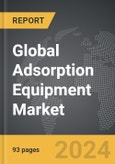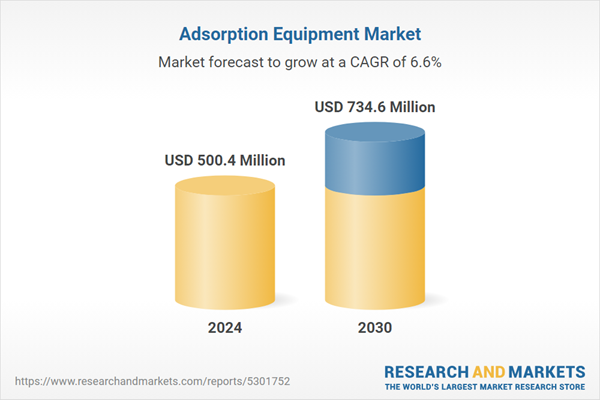The global market for Adsorption Equipment was valued at US$500.4 Million in 2024 and is projected to reach US$734.6 Million by 2030, growing at a CAGR of 6.6% from 2024 to 2030. This comprehensive report provides an in-depth analysis of market trends, drivers, and forecasts, helping you make informed business decisions. The report includes the most recent global tariff developments and how they impact the Adsorption Equipment market.
Segments: Capacity (Above 50,000 CFM, 10,000-50,000 CFM, Less Than 10,000 CFM); End-Use (Automotive Paints, Chemical, Semiconductor, Printing, Other End-Uses).
Geographic Regions/Countries: World; United States; Canada; Japan; China; Europe (France; Germany; Italy; United Kingdom; Spain; Russia; and Rest of Europe); Asia-Pacific (Australia; India; South Korea; and Rest of Asia-Pacific); Latin America (Argentina; Brazil; Mexico; and Rest of Latin America); Middle East (Iran; Israel; Saudi Arabia; United Arab Emirates; and Rest of Middle East); and Africa.
The analysts continuously track trade developments worldwide, drawing insights from leading global economists and over 200 industry and policy institutions, including think tanks, trade organizations, and national economic advisory bodies. This intelligence is integrated into forecasting models to provide timely, data-driven analysis of emerging risks and opportunities.
Global Adsorption Equipment Market - Key Trends and Drivers Summarized
What Is Adsorption Equipment and Why Is It Important?
Adsorption equipment is a critical component in a variety of industrial processes, used to separate and purify gases or liquids by binding specific molecules onto a solid surface. This technology is utilized in industries ranging from chemical manufacturing and gas processing to water treatment and air purification. The principle behind adsorption is that molecules adhere to the surface of an adsorbent material, unlike absorption where molecules penetrate into the bulk of the absorbing medium. Common adsorbents include materials such as activated carbon, silica gel, and zeolites, all known for their large surface area and high porosity, making them highly efficient at capturing contaminants or unwanted compounds. Adsorption equipment is crucial in processes where removing impurities, toxins, or pollutants is essential for ensuring product quality, safety, or environmental compliance. For example, it is employed in removing volatile organic compounds (VOCs) from industrial emissions, purifying natural gas, or eliminating toxic chemicals from wastewater. As industries increasingly seek solutions that are both economically and environmentally sustainable, adsorption technology has gained prominence for its versatility and efficiency in addressing pollution and purification challenges.How Does Adsorption Technology Work?
Adsorption equipment operates through a process where a fluid, either a gas or liquid, passes over a bed of solid adsorbent material. This bed is often housed in a cylindrical vessel, where the adsorbent captures target molecules through intermolecular forces or chemical reactions on its surface. The process can be carried out in either batch or continuous modes, depending on the operational needs. Batch systems, where the adsorbent is used until it reaches its saturation point and then either replaced or regenerated, are common in smaller-scale operations. In contrast, continuous systems, which are preferred for large-scale industrial processes, often use two or more beds of adsorbent material. While one bed is actively adsorbing, the other can be regenerated using methods such as pressure swing adsorption (PSA), temperature swing adsorption (TSA), or vacuum swing adsorption (VSA). Each regeneration technique is chosen based on the specific properties of the adsorbate and the operational environment. The efficiency of an adsorption system depends heavily on the characteristics of the adsorbent material, including its surface area, pore size distribution, and affinity for the specific molecules being targeted. Advanced synthetic adsorbents and nano-materials are pushing the boundaries of adsorption technology, offering higher efficiency and selectivity, making the process more cost-effective and suitable for a broader range of applications.Why Is Adsorption Equipment Gaining Traction in Various Industries?
The adoption of adsorption equipment has seen significant growth across various industries due to its ability to meet stringent environmental regulations and its effectiveness in enhancing the purity of products. In the environmental sector, the need for air and water purification is paramount as governments enforce stricter limits on the emission of hazardous substances, such as sulfur oxides (SOx), nitrogen oxides (NOx), and carbon dioxide (CO2). Adsorption technology is increasingly used to control industrial emissions and improve air quality by capturing these harmful pollutants. Furthermore, adsorption equipment is widely employed in the water treatment industry, where it is used to remove organic contaminants, heavy metals, and other toxins from drinking water and industrial wastewater. The food and beverage sector also benefits from this technology, using it to ensure the quality and safety of products by eliminating impurities that could affect taste, color, or safety. In the gas and energy sectors, adsorption is vital for the purification of natural gas and biogas, removing contaminants such as hydrogen sulfide (H2S) and CO2, ensuring the gas meets required standards. Additionally, the pharmaceutical industry increasingly relies on adsorption processes for purification during drug manufacturing, as well as for the controlled release of active ingredients. The versatility and efficiency of adsorption technology make it a go-to solution for industries focused on both regulatory compliance and operational efficiency, contributing to its widespread adoption.What Factors Are Driving the Growth of the Adsorption Equipment Market?
The growth in the adsorption equipment market is driven by several factors that are shaping the direction of industrial practices and environmental regulations globally. One of the most significant drivers is the increasing focus on reducing industrial emissions and meeting stricter environmental regulations, especially in sectors like oil and gas, chemical manufacturing, and power generation. Governments around the world are imposing more stringent standards for air and water quality, leading to a heightened demand for technologies like adsorption that can effectively capture harmful pollutants. The rise in consumer awareness regarding environmental sustainability is also pushing industries to adopt cleaner technologies, creating a ripple effect across sectors. Additionally, the ongoing advancements in adsorbent materials are a major growth driver. Innovations such as synthetic zeolites, metal-organic frameworks (MOFs), and nano-adsorbents are enabling higher adsorption capacities, faster regeneration cycles, and better selectivity, making adsorption equipment more effective and versatile. These technological improvements are particularly important in industries like pharmaceuticals, electronics, and food processing, where precision and purity are critical. Moreover, the shift toward circular economy models and zero-emission goals is encouraging industries to invest in adsorption technologies for both waste management and resource recovery. For example, the capture and reuse of CO2 from industrial emissions is gaining traction as part of broader decarbonization efforts. This combination of regulatory pressure, technological advancement, and a focus on sustainability is driving robust growth in the adsorption equipment market, positioning it as a key solution for industries aiming to achieve cleaner, more efficient operations.Report Scope
The report analyzes the Adsorption Equipment market, presented in terms of units. The analysis covers the key segments and geographic regions outlined below.Segments: Capacity (Above 50,000 CFM, 10,000-50,000 CFM, Less Than 10,000 CFM); End-Use (Automotive Paints, Chemical, Semiconductor, Printing, Other End-Uses).
Geographic Regions/Countries: World; United States; Canada; Japan; China; Europe (France; Germany; Italy; United Kingdom; Spain; Russia; and Rest of Europe); Asia-Pacific (Australia; India; South Korea; and Rest of Asia-Pacific); Latin America (Argentina; Brazil; Mexico; and Rest of Latin America); Middle East (Iran; Israel; Saudi Arabia; United Arab Emirates; and Rest of Middle East); and Africa.
Key Insights:
- Market Growth: Understand the significant growth trajectory of the Above 50,000 CFM segment, which is expected to reach US$272.3 Million by 2030 with a CAGR of a 5.7%. The 10,000-50,000 CFM segment is also set to grow at 7.6% CAGR over the analysis period.
- Regional Analysis: Gain insights into the U.S. market, valued at $130.5 Million in 2024, and China, forecasted to grow at an impressive 9.6% CAGR to reach $165.9 Million by 2030. Discover growth trends in other key regions, including Japan, Canada, Germany, and the Asia-Pacific.
Why You Should Buy This Report:
- Detailed Market Analysis: Access a thorough analysis of the Global Adsorption Equipment Market, covering all major geographic regions and market segments.
- Competitive Insights: Get an overview of the competitive landscape, including the market presence of major players across different geographies.
- Future Trends and Drivers: Understand the key trends and drivers shaping the future of the Global Adsorption Equipment Market.
- Actionable Insights: Benefit from actionable insights that can help you identify new revenue opportunities and make strategic business decisions.
Key Questions Answered:
- How is the Global Adsorption Equipment Market expected to evolve by 2030?
- What are the main drivers and restraints affecting the market?
- Which market segments will grow the most over the forecast period?
- How will market shares for different regions and segments change by 2030?
- Who are the leading players in the market, and what are their prospects?
Report Features:
- Comprehensive Market Data: Independent analysis of annual sales and market forecasts in US$ Million from 2024 to 2030.
- In-Depth Regional Analysis: Detailed insights into key markets, including the U.S., China, Japan, Canada, Europe, Asia-Pacific, Latin America, Middle East, and Africa.
- Company Profiles: Coverage of players such as CECO Environmental, Chemisch Thermische Prozesstechnik (CTP) GmbH, Coastal Environmental Systems, Inc., Durr Aktiengesellschaft, EISENMANN SE and more.
- Complimentary Updates: Receive free report updates for one year to keep you informed of the latest market developments.
Some of the 42 companies featured in this Adsorption Equipment market report include:
- CECO Environmental
- Chemisch Thermische Prozesstechnik (CTP) GmbH
- Coastal Environmental Systems, Inc.
- Durr Aktiengesellschaft
- EISENMANN SE
- Environmental C & C Inc.
- Evoqua Water Technologies LLC
- Gulf Coast Environmental Systems
- Monroe Environmental Corp.
- Taikisha Engineering India Pvt. Ltd.,
- TAIKISHA LIMITE
- TIGG LLC (US)
Tariff Impact Analysis: Key Insights for 2025
Global tariff negotiations across 180+ countries are reshaping supply chains, costs, and competitiveness. This report reflects the latest developments as of April 2025 and incorporates forward-looking insights into the market outlook.The analysts continuously track trade developments worldwide, drawing insights from leading global economists and over 200 industry and policy institutions, including think tanks, trade organizations, and national economic advisory bodies. This intelligence is integrated into forecasting models to provide timely, data-driven analysis of emerging risks and opportunities.
What’s Included in This Edition:
- Tariff-adjusted market forecasts by region and segment
- Analysis of cost and supply chain implications by sourcing and trade exposure
- Strategic insights into geographic shifts
Buyers receive a free July 2025 update with:
- Finalized tariff impacts and new trade agreement effects
- Updated projections reflecting global sourcing and cost shifts
- Expanded country-specific coverage across the industry
Table of Contents
I. METHODOLOGYII. EXECUTIVE SUMMARY2. FOCUS ON SELECT PLAYERSIII. MARKET ANALYSISSOUTH KOREAREST OF ASIA-PACIFICARGENTINABRAZILMEXICOREST OF LATIN AMERICAIRANISRAELSAUDI ARABIAUNITED ARAB EMIRATESREST OF MIDDLE EASTIV. COMPETITION
1. MARKET OVERVIEW
3. MARKET TRENDS & DRIVERS
4. GLOBAL MARKET PERSPECTIVE
UNITED STATES
CANADA
JAPAN
CHINA
EUROPE
FRANCE
GERMANY
ITALY
UNITED KINGDOM
SPAIN
RUSSIA
REST OF EUROPE
ASIA-PACIFIC
AUSTRALIA
INDIA
LATIN AMERICA
MIDDLE EAST
AFRICA
Companies Mentioned (Partial List)
A selection of companies mentioned in this report includes, but is not limited to:
- CECO Environmental
- Chemisch Thermische Prozesstechnik (CTP) GmbH
- Coastal Environmental Systems, Inc.
- Durr Aktiengesellschaft
- EISENMANN SE
- Environmental C & C Inc.
- Evoqua Water Technologies LLC
- Gulf Coast Environmental Systems
- Monroe Environmental Corp.
- Taikisha Engineering India Pvt. Ltd.,
- TAIKISHA LIMITE
- TIGG LLC (US)
Table Information
| Report Attribute | Details |
|---|---|
| No. of Pages | 93 |
| Published | April 2025 |
| Forecast Period | 2024 - 2030 |
| Estimated Market Value ( USD | $ 500.4 Million |
| Forecasted Market Value ( USD | $ 734.6 Million |
| Compound Annual Growth Rate | 6.6% |
| Regions Covered | Global |









